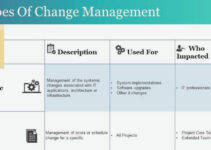When businesses and companies fall behind in the competition and can’t achieve marketing goals and objectives. It requires them to change the status quo and bring mass-scale organizational changes. Of course, change always comes with risks. While making the change decision, may seem highly risky it is much better than not taking the risks. Today, we’ll discuss the top organizational change risks; risks of change management; and how they impact the company in multiple ways.
The change management project is the integration of strategies and practices for effective planning and execution of desired. The change process comprises of following steps;
- Recognizing and acknowledging the need for change
- Developing a change plan relevant to the company’s needs and demands
- Communicating the plan with employees and team members
- Conducting training programs to improve their skill and expertise
- Executing the new procedures and policies
- Monitoring and evaluating the results
According to a study, approximately 70% of the change projects fail to reach their desired goals and objectives. It makes the change management initiative very significant and risky.
Organizational Change Risks
Let’s discuss the main organizational change risks or the risks of change management and some of them are as follows;
Operational Interruption
The riskiness of the change initiative becomes apparent when it interrupts the company’s operation. The scale and duration of interruption are reliant on the size of the company and the complexity of the organizational structure and change project.
For instance, the software update of the small company would be completed within a few hours without any disruptions. On the other hand, if a big enterprise is introducing a new ERP solution, then it would greatly disrupt the company’s operations. In order to decrease the financial impact of the change program, you should take the following steps;
- Schedule and execute the changes in phases
- Hardware and software changes on the weekends
- Conducting training programs for employees
- Employing new systems and processes
Change Leadership
The success of the change project is heavily reliant on the leadership. You need to ensure that the managers and supervisors in the affected departments have sufficient experience and skill expertise to deal with the changes. The leadership should have a strong commitment and believe in the change project. The strong commitment and conviction would help them to maintain focus in unexpected situations while implementing the changes.
Employee Resistance
The resistance of employees and team members is the main risky element. Employees and people are usually hesitant and reluctant to adopt new changes. However, it is because of various reasons like previous bad experiences with the change project. They may have a fear of losing their job while implementing the new automation technology and new system. In order to deal with change resistance, it is significant that they should implement changes in multiple stages; rather than implementing all at once.
Customer Experience
Businesses and companies should implement the changes in such a way that it won’t impact the customer experience. If they aren’t careful, then it would jeopardize the company’s change initiative. Research studies have shown that poor execution of the change project would decrease the quality of work, lower productivity, and employees’ morale.
Ultimately, it impacts the company’s capability of serving and communicating with customers. If customers don’t receive the desired and required services from the company; then it amplifies the customer dissatisfaction level.
Losing Valuable Employees
It is difficult to measure the overall cost of the change project, but we are aware of the fact that it is highly costly to replace valuable customers. Poorly communicating the goals and objectives of the change project causes confusion and stress among employees and team members. The division and friction among employees result in the form of unexpected operations; the company loses valuable and talented employees.
Future Legacy
Poor and failed execution of the change initiative jeopardizes the company’s record and legacy for future change initiatives. It becomes significant when there is limited trust and confidence among employees and team members while executing the change initiative. Usually, it happens when the corporate executive and investors are reluctant to allocate time and resources for the change initiative. Either they don’t believe in the change project, or they have experienced a history of failed change projects.
Expensive
One of the main risks and reasons behind the failure of the change projects is that the company’s leadership allocates limited time and resources for the change project. It results in the form of delays, push-back, and resistance. Management should be aware of the fact that change is a continuous process; they need to update their strategies and policies in the dynamic business environment. For instance, if the company doesn’t have the luxury of providing extra funds for the change project, then it leads to failure.
Conclusion: Organizational Change Risks | Risks of Change Management
After an in-depth study of the organizational change risks; we have realized that the change management project comes with a lot of risk factors. If you are learning about the risks of change management; then you should keep in mind the abovementioned top risk factors.
Ahsan is an accomplished researcher and has a deep insight in worldly life affairs. He goes Live 3 days a week on various social media platforms. Other than research writing, he’s a very interesting person.


